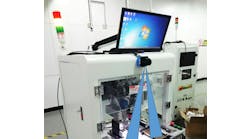A Control Design reader writes: As an automation engineer at a large discrete part manufacturer, I need to create a factory-acceptance-test (FAT) plan for a $2 million high-speed, automated system. It has multiple stations with several robots, motion control, vision inspections and many fieldbus digital and analog I/O. The question is what should I include in a FAT? I don't know where to start. Also, are there diagnostic tools or software to make performing the defined tests easier to complete? What do you suggest?
[javascriptSnippet]
ANSWER
No two FATs are the same
A FAT is a “factory debug” to assure that when the system arrives on site, it should be able to be installed and get up and running quickly and smoothly.
While there are standard tests that are routinely conducted, there is no set checklist during a FAT; it can consist of a variety of inspection points and tests per the request of the customer, based on your requirements and unique equipment specifications. In general, the following things are covered during a FAT:
- comprehensive inspection—this is typically customized based on the equipment and the requests of the customer, but can include a range of conformity checks and verifications, such as whether the actual equipment matches up to the drawings and name plate data
- contract audit—this consists of a review of the original agreement to make sure all contractual obligations are met
- function test—this procedure simulates the system in operation to provide proof of functionality; these tests usually include verification of relevant documents, including user manuals, P&IDs and any type of instructions that come with the equipment to make sure they are accurate.
It’s important to note here that there are varying levels of a FAT. They can be performed at a very basic level, such as setting up the main pieces of the system with temporary wiring and making sure everything moves as it is supposed to; or a more complete FAT can be conducted where the manufacturer physically builds the whole system in the shop to test it fully. In the latter example, the system is then taken apart moved to the customer’s site and put back together again.
FATs are beneficial not just for the buyer and end users but for the manufacturer, as well. Both parties can be assured that the equipment meets all the contractual specifications and any issues can be addressed before arriving at the customer’s site. Rectifying issues while the system is still in the possession of the manufacturer helps to keep the project on track and within budget. FATs almost always save time and money over fixing issues in the field.
The safety of your employees is always a top concern, so the quality assurance gives you the peace of mind that all components of your system are functioning the way they should and within the full range of operating specifications.
Additionally, FATs help to determine who is responsible for the problems that are identified. Sometimes the issues are the manufacturer’s responsibility, for example, when an instrument doesn’t work properly. Other times they are the customer’s responsibility. For example, if a customer decides, after seeing the physical layout, that it wants to reconfigure the design, the manufacturer can move things around prior to shipping it to site.
All inspections and testing are done at the vendor’s location, usually on the shop floor so that when/if issues arise, they are in an area that is convenient for modifications to be made to the equipment. Since the purpose of a FAT is to qualify the equipment prior to shipment, it should never be conducted at the customer’s facility.
The manufacturer and customer can choose whomever they would like from their companies to be present during the factory acceptance test. It’s a good idea to have any/all of the following on location:
- project managers
- operators
- plant engineers
- maintenance personnel.
The more valuable input that is received from both parties, the more successful the test will be, which will help to facilitate a fast-track startup.
As we’ve mentioned, it’s hard to outline exactly what a factory acceptance test consists of because each one is unique to the equipment it involves and the specialized requirements of the customer. While keeping in mind that no two are alike, here is an example to give you a better idea of the inspection points and tests that are used to validate the equipment. This example is for an automated reactor system:
- scope—the tests to be performed by the manufacturer to establish acceptability of the equipment and the conformance with the applicable drawings and specifications
- applicable standards and specifications—a list of any relevant safety guidelines published by National Electrical Manufacturers Association (NEMA) or National Electric Code (NEC), for example
- reference documents—a complete set of all relevant documents to be available during the execution of the FAT and marked up as required; these drawings are usually located in an appendix at the back of the protocol
- testing equipment—a list of the equipment and instrumentation, such as vacuum gauge or tachometer, used during this test
- system skid has its own list:
- a. Verify all lines and components are present and installed as per the plan. Check that components are new, anchored sufficiently to frame and built in accordance with the specifications outlined in the applicable list.
- b. Verify equipment is fabricated as per drawings and manufacturing quality meets expectations.
- c. Verify pressure, temperature and material information on the National Board nameplate to be consistent with specifications.
- d. Verify motor manufacturer, model and serial number. Also confirm motor classification meets specified class and division standards.
- e. Verify lines hold pressure when fully assembled; record pressure at start and stop. This test is generally conducted for 60 minutes to ensure the system meets the acceptance criteria.
- f. Verify lines hold vacuum when fully assembled; record pressure at start and stop. This test is also conducted for 60 minutes to ensure the system meets the acceptance criteria.
- g. Verify that system documentation is complete.
Each test should yield an acceptable result with no issues. Corrective steps will be taken if a test fails and any retesting will be performed if required. Some tests may require additional testing or clarification of the testing methods. Under these conditions, additional comments will be documented in the deviation section of the FAT. Deviations are redlined to be captured in final as-built drawings.
A list of remaining follow-up items should be put together to note any modifications/adjustments or additional tests that need to be made prior to delivery. Make sure to verify panel component checks, auto mode controls (agitator), manual mode controls (reactor on-off valves, modulating valves), analog displays, sequences (system purge, pressure/vacuum control, system leak test, charge liquids, reflux/solvent strip, exothermic additions interlocks) and reactor light operations.
By systematically carrying out all items on the checklist, all FAT participants from both sides can gain the assurance needed to feel prepared and ready for start-up.
There are numerous advantages to having a FAT, for both parties involved. The seller can ensure that the system is operational and the project is optimized to stay on track to be delivered on time. The buyer can qualify the equipment against the contractual agreement as per the order specifications.
It is important to note that it is not uncommon for there to be minor glitches the first time new systems are powered up. The benefit of conducting a FAT is that the manufacturer can take care of typical first-run issues.
There are numerous additional benefits:
- Customers can “touch and feel” the equipment while it is in operational mode before it ships.
- The manufacturer can provide some initial hands-on training to the customer, giving operating personnel more confidence when running the machinery for the first time in real-world settings.
- Key project people from both sides are together, making it an ideal time to review the bill of materials, discuss required and recommended spare parts (for start-up and first year of operation) and review maintenance procedures and equipment limitations.
- The thorough FAT documentation can be used as a template for the Installation Qualification portion of the validated process/installation.
- Based on the results of the FAT, both parties can create a punch list of additional items that need to be addressed prior to shipment.
Times can vary depending on the complexity of the system and the corresponding FAT, but they are typically scheduled 2-4 weeks prior to the ship date to help maintain on-time delivery. The duration of the FAT can be anywhere from one day up to a couple of weeks.
There is no extra cost for the customer to have a FAT performed on the system as it is generally included in the scope of the project. That being said, the expense that is factored into the project for FAT is dependent on the customer’s requirements. It is very important for you to communicate early in the project exactly what your testing needs are so the criteria can be outlined and agreed upon by both parties. This helps to set your expectations to the manufacturer, and the manufacturer will be sure to include the relevant tests in your checklist.
While FATs can be costly for the manufacturer with respect to the time and labor involved in performing them, it’s more time and cost effective to do a FAT and do it right to mitigate any issues prior to delivery.
A FAT gives manufacturers and you, the customer, an opportunity to do a trial run and see the equipment in operation before it is installed in your facility. This makes any modifications and adjustments much easier to make and ensures the equipment will run with full operational efficiency. It is proven that when verifying, inspecting, and testing is performed prior to shipment, it greatly reduces start-up issues once the equipment arrives at your site. With a thorough factory acceptance test performed, you can be confident in the system you are receiving and be ready to put it into production.
DANIEL WEISS / senior product manager / Newark






